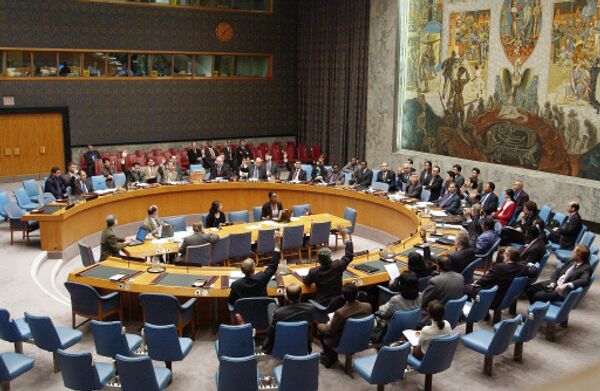Russia and China have reached an agreement with the United States and the other permanent members of the UN Security Council on imposing slightly tougher sanctions on Iran for its nuclear program. This event roughly coincided with the anniversary of a milestone in the history of Russian-Iranian relations: on May 20, 1920, the two countries officially recognized one another.
Surveying the history that followed, one is struck by a strange trend: most major anniversaries are accompanied by tensions. It is as if Iran were a challenge sent from on high to test Russia's diplomatic resolve.
Diplomatic recognition followed the establishment of Soviet rule in Azerbaijan, when Iranian businesses began pressing their government for permission to work with the Soviets. In 1917, Moscow gave Iran a rare gift by withdrawing from the treaty dividing up Persia (Iran). On February 26, 1921, following diplomatic recognition, Russia and Iran signed an agreement by which Soviet Russia relinquished all assets formerly owned by the imperial regime, including ports, roads, banks, and more. If Britain, the most influential player in Iran, had any kind feelings toward Lenin and Trotsky, this anti-colonial propaganda surely squashed them.
However, twenty years later (an anniversary year), Tehran found itself in Nazi Germany's sphere of influence. In 1941, Germany even planned to use Iran as a bridgehead from which to launch its invasion of the Caucasus. Arms were supplied through Iran, and the country was teeming with spies. Moscow had to join forces with its long-time enemy, Britain, to invade Iran in late summer of 1941. That is why the famous Tehran Conference of November-December 1943, which essentially established the Allied coalition, was held where it was.
Russia and Iran did not exactly become best friend after that. Moscow and Tehran found themselves on opposing sides as another anniversary drew near twenty years later. Instead of signing a non-aggression agreement with the Soviet Union, as planned, Iran signed a similar treaty with the United States. The treaty involved military cooperation, which nearly caused a break in Soviet-Iranian relations. However, as tensions boiled over during the Cuban Missile Crisis, Tehran announced in the fall of 1962 that it would no longer host foreign missile bases or allow its territory to be used as a foothold for an attack on the Soviet Union. If you like adrenaline rushes, try negotiating with the Iranians.
A period of stability followed; but, as a new anniversary drew near in 1980, revolution broke out in Iran. In the eyes of the new government, the Soviet Union was the "Lesser Satan," as opposed to the "Great Satan," the United States. Looking back, it was a clear sign that the bipolar world was on its way out. The Soviet Union had to start over with Iran.
In 1990, it was the Soviet Union that was condemning Iran for issuing a fatwa calling on Muslims to kill the writer Salman Rushdie for his allegedly anti-Muslim novel The Satanic Verses. This was a different Russia, one in which the public was strongly opposed to punishing writers for their work - something the Soviet Union had a lot of experience with. Excerpts from The Satanic Verses were published in the Soviet Union in 1990.
The year 2000 was different. It came five years after Moscow broke off military ties with Iran as part of the Gore-Chernomyrdin agreements; however, the war in Yugoslavia in 1999 caused Moscow to reverse course. The Russian defense minister, Igor Sergeyev, went to Tehran to negotiate a restoration of defense cooperation.
Moscow has been defending Iran for years from the attacks of various U.S. administrations, sometimes putting its own interests at risk in the process. Admittedly, a U.S.-Iranian war during George W. Bush's tenure would have been a far worse outcome, as it would have caused a geopolitical catastrophe in the Caspian region and Central Asia. That became the focus, and everything else was put on the backburner. But now the situation is different. Tehran seems intent on creating problems for itself.
Maybe the key lies in Iranian civilization itself. Diplomatic relations are limited to the views of diplomats, secretary-generals, presidents and shahs. The do not reflect the country itself - ancient Iran and its amazing culture. The future of Russian-Iranian relations will largely depend on the interactions between their people, regardless of the tensions between their governments. The time has come for people to officially recognize one another, not just states.
Russians would discover many interesting things. Iran is one of the oldest continuous civilizations, along with India and China. Iran existed three thousand years before Christ, when Europe was still quiet. Traveling to Iran and talking to the people of this ancient culture is fascinating. People of ancient civilizations always have a unique perspective.
Iran has made a major contribution to the emergence of a main world religion. They invented their own form of government, and the country has produced more great poets than any other (their work is available in translation). And before Peter the Great introduced wigs and other European fashions in Russia, Russians were perfectly comfortable in their kaftans, sarafans, and other clothes with Persian names.
The opinions expressed in this article are the author's alone and do not necessarily represent those of RIA Novosti.
MOSCOW. (Dmitry Kosyrev, RIA Novosti political commentator)

